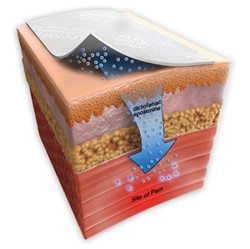Medications For Osteoarthritis
Prescription and Non Prescription Drugs
![]()
Medications For Osteoarthritis |
 Flector Patch: Drugs seep through the skin to relieve pain directly in the joint. |
Osteoarthritis DrugsContents • Painkillers |
|
Return To Main Article Osteoarthritis Guide |
Can Drugs Cure Osteoarthritis? No. Medications used for treating osteoarthritis are aimed at easing symptoms (primarily pain) associated with the disease. Currently no drug exists that will halt the course of the osteoarthritis; although drug companies continue to pursue this potentially lucrative cure. The following is a list of the most common prescription and non prescription medications taken for treating the condition. NSAIDs And Acetaminophen
Taking NSAIDS And Acetaminophen
A Note About NSAIDs NSAIDs block the production of prostaglandins in the body, a substance that plays a role in pain, inflammation, aches, muscle cramps and fever. At low doses they work as a pain reliever, in higher doses they can reduce inflammation as well as relieve pain. NSAIDs in lower doses are available over the counter (including a subclass called COX-2), higher doses usually require prescription. Someone suffering from rheumatoid arthritis, an inflammatory type of arthritis will find more benefit in taking higher doses of NSAIDs than someone with osteoarthritis (which is not generally associated with inflammation). No NSAID is more effective than the other. However, they can differ significantly in price, so cost may be an important factor in which one you choose. Chain stores like Walmart, Kroger, Target and Sam's Club offer generic (non-branded) drugs for $4 or a 3-month supply for $10. Some programs have restrictions or membership fees, so be sure to check that your drug is covered before joining. Stronger Painkillers If you cannot take NSAIDs, or if other treatments have failed to reduce pain, your doctor may prescribe opioids (also called narcotics). These stronger painkillers include morphine (Avinza and Kadian), codeine, hydrocodone (Vicodin) and oxycodone (Percocet and OxyContin). They carry a risk of dependence, although the risk is considered small in people suffering from severe pain. Doctors generally reserve opioids for short-term use. If your pain is persistent enough to warrant long-term use of strong painkillers, your doctor will probably tell you it is time for surgery. Read more about surgical treatments for osteoarthritis.
Your doctor may also prescribe a topical pain-relieving cream, rub or spray, which is applied directly to the skin over painful joints. Capsaicin skin creams (such as Zostrix and Theragen) can help with mild pain. The main benefit of topical painkillers is that they have fewer side effects than painkiller pills and they can be applied directly to the skin on the joint. Salicylate skin creams (like Aspercreme or Bengay Arthritis) do not work for pain caused by osteoarthritis. Other alternatives include voltaren gel and Flector patch. Both release the NSAID medication diclofenac directly through the skin to the affected joint. The patch releases the medication slowly over a 12 hour period. Both voltaren and Flector patch are prescription only. Topical medications tend to work better on joints that are near the skin surface such as the fingers, knee and toes. They are less effective on deeper joints like those in the hips. According to new findings by a study presented at European Congress on Osteoporosis and Osteoarthritis (ECCEO) in 2012, costly hip and knee replacement surgeries could be avoided by giving patients a drug called Protelos (Strontium ranelate). Protelos is already used to prevent osteoporosis (brittle bone disease) in postmenopausal women. This powder, mixed with water to make a lemon-flavored drink, appears to significantly reduce pain and increase mobility in patients with osteoarthritis. According to the manufacturers "for the first time we have a treatment that can slow the development of this debilitating disease". However, it is early days. Although protelos has a good safety record associated with osteoporosis, this is still only the first study on protelos + osteoarthritis. More studies are needed before it becomes licensed as a treatment for osteoarthritis.
|
| Related Articles on Osteoarthritis
For more information, see the following: • Osteoarthritis diagnosis: Tests and examinations. Back to Homepage: Womens Health Advice |
|
WOMENS HEALTH ADVICE: ABOUT OSTEOARTHRITIS |